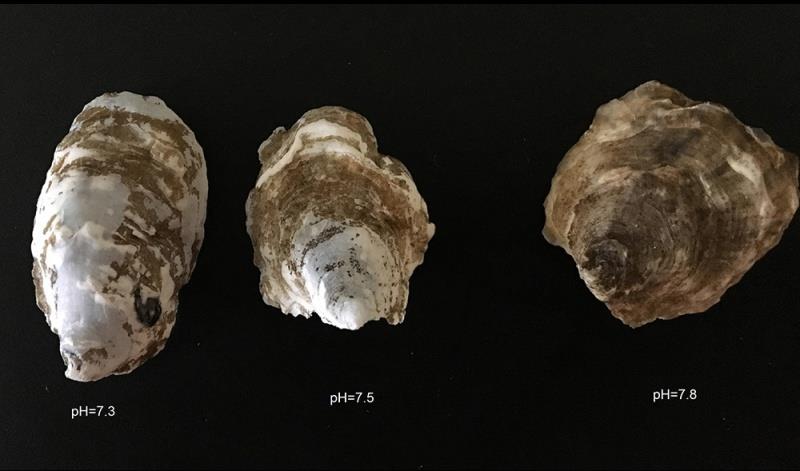
How will changing ocean chemistry affect the shellfish we eat?
by NOAA Fisheries 12 Apr 2019 12:00 UTC

Oyster shell observed during acidification experiment. Lowest pH treatment has lighter weight shells and translucent areas © NOAA Fisheries
Most of us have heard that the climate is changing as our atmosphere deals with a massive increase in carbon dioxide emissions. While climate change gets most of the publicity, did you know that the ocean absorbs about a quarter of that extra carbon dioxide?
There are pros and cons to this: the ocean provides a buffer without which our climate would warm more rapidly, but the process of absorbing carbon dioxide is making the ocean less basic and more acidic. Ocean acidification is happening in places most of us don't regularly visit, but it has the potential to radically change conditions for the sea life we know and rely on for sustenance.
The pH scale measures how acidic a substance is, ranging from 0 to 14. The lower the number, the more acidic the substance. pH 7 is neutral, neither acidic or basic. Substances below pH 7 are considered acidic, while substances above pH 7 are considered basic (or alkaline). The scale is logarithmic, meaning that as you go down by one number, a substance is actually ten times more acidic than the next highest value, for example, a pH of 5 is ten times more acidic than a pH of 6. It helps to consider examples from everyday life: Lemon juice? Very acidic, with a pH of about 2. Milk? Just under 7, which is neutral. Oven cleaner? Very basic at pH 13.
Typical Long Island Sound water has a pH of around 7.8, while sea water in the open ocean is around 8.1. Scientists estimate that the pH of surface ocean water has dropped by 30% since the beginning of the Industrial Revolution. Learn more about ocean acidification
Scientists at the NEFSC Milford Lab are shining some light on ocean acidification by examining how a more acidic ocean affects something we care about the oysters, surfclams, and scallops that we eat.
Changing ocean chemistry could have a variety of consequences for shellfish. It could hinder shell-building, as the calcium carbonate building blocks shellfish need to make their shells become less abundant and the surrounding seawater gets more corrosive. In addition, their metabolism, including feeding and respiration rates, could be affected.
The Experiment: Ocean Acidification and Oysters
As the winter holidays approached in 2018, the Milford Lab was abuzz with activity as scientists took samples from two experimental systems they have designed to test what happens to shellfish when the water they live in becomes more acidic. The subjects of this first experiment were seven-month-old "seed" oysters, a term used in aquaculture to describe young oysters that are ready to be transplanted from a hatchery into a natural environment. Tests on young surfclams will get under way in April 2019.
For ten weeks in November and December 2018, Milford scientists measured feeding, growth, and respiration in two groups of oysters, fed and unfed, under three different pH levels: typical Long Island Sound water at 7.8, 7.5, and a low pH treatment of 7.3.
The fed experiments allowed researchers to study the effects of pH on filtration and feeding. The unfed experiments (food - in this case, algae, was filtered out of the water before it reached the oysters) allowed researchers to measure the effects of pH on the energy an oyster needs to carry out metabolic processes necessary for survival, including respiration.
There are many moving parts to this project. Reflecting on the camaraderie within the project team, post-doctoral researcher Emilien Pousse noted with appreciation, "At one point or another, half the lab was working on this experiment."
Milford scientists took respiration measurements, measured feeding rates, and tracked the amount of oyster food (algae), in the water over ten weeks. The two ocean acidification experimental systems used were built by research chemist George Sennefelder and research technician Dylan Redman. Shannon Meseck, a research chemist and member of the Northeast Coastal Acidification Network Science Working Group, leads the project.
Comparing Responses: Oysters and Surfclams
Data from the first experiment are still being analyzed, but the team has already found that shell weight was significantly lower in oysters from the low-pH treatment than those kept at the typical pH of Long Island Sound. The team is now analyzing data on feeding and respiration rates, looking for potential differences in metabolism between the treatment groups.
Oysters and surfclams have different methods of building their shells. After running the experiment on surfclams, the team plans to compare their responses to find out whether they are affected by ocean acidification in similar or different ways. In 2020, the team will work with Massachusetts Maritime Academy to study the responses of sea scallops to ocean acidification. Both surfclams and sea scallops are federally-managed species, and the scallop fishery is the most valuable in the northeast.
The results of this project will support forecasting of fishery responses to climate change and provide recommendations for both oyster growers and those working in the surfclam and scallop fisheries. Overall, it will help predict the effects of ocean acidification on both the ecosystem and the economy.